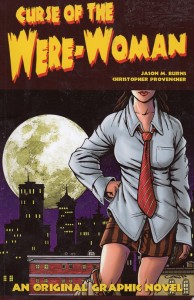Comic Book Review: Curse of the Were-Woman Written by Jason M. Burns, Art by Christopher Provencher
Patrick Dalton likes to think of himself as an “alpha male.” He’s on the fast track to a partnership at his advertising agency, in excellent health, handsome, and gets laid practically every night. This last makes Patrick the envy of his best friend Andy, who married the first woman that would take him, but likes to hear about conquests.
One of Patrick’s most important rules is that he never has sex with the same woman twice, and certainly not in a row. He thinks this is best for both them and him, as he doesn’t want them to get attached and cramp his style. He’s about to pull a disappearing act on his latest conquest, Tessa, when she wakes up and throws a fit. He thinks he’s gotten away, but Patrick doesn’t know that Tessa is an actual magical witch.
Now Patrick becomes Patricia at nightfall every night, being restored at dawn, and he will remain a were-woman until he learns to truly understand and respect women. Even with a little help from his new next door neighbor Amber, that might take longer than Patrick is comfortable with.
As you might guess, Patrick is a horrible person at the start of the story; one of those smug people who attributes bad reactions to his self-centered actions as jealousy or “wimmen be crazy.” He scores often with his smooth veneer and surface manipulation, but he hasn’t figured out there are more important things than getting your rocks off.
And indeed, while Patrick/Patricia goes through some humiliating and painful experiences (getting a period on the second night!), the real point of the exercise is teaching him how to have an actual relationship with a woman. And along the way, he learns to have more respect even for women he’s not attracted to.
As one might expect, there’s quite a bit of sexism on display here, mostly from Patrick, but his boss is exactly the sort of person you’d expect to promote a guy like Patrick, and Andy has learned nothing from his marriage. (Andy’s wife is the stereotype of the woman who “let herself go” after the wedding, as well as a ball-buster.)
There’s vulgarity and sexual situations, so definitely not for children, but no on-screen sex, and nudity confined to some cleavage and a quick glimpse of Patricia’s backside.
Those familiar with the gender-bender subgenre will find little new here, and the art is only so-so, but it’s nice to have an entire graphic novel in this category.
Overall, this romantic comedy is okay, but not a must-have.

